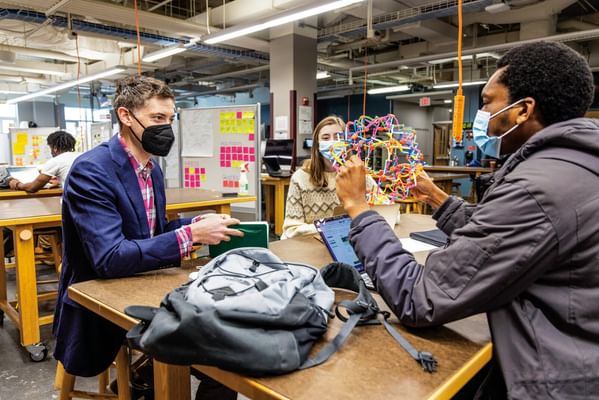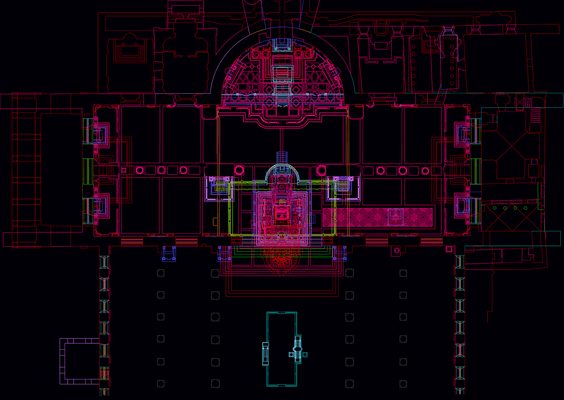- Undergraduate
Bachelor's Degrees
Bachelor of ArtsBachelor of EngineeringDual-Degree ProgramUndergraduate AdmissionsUndergraduate Experience
- Graduate
Graduate Experience
- Research
- Entrepreneurship
- Community
- About
-
Search
All Thayer News


New Interdisciplinary Projects Infuse Design Thinking Across Campus
Jul 01, 2022 | by Theresa D'Orsi | Dartmouth Engineer
Faculty throughout Dartmouth are harnessing the power of design thinking, engineering, and the liberal arts to bring new insights to their research and teaching through a series of new projects sponsored by the Design Initiative at Dartmouth (DIAD).

Rafe Steinhauer will build on the “Range and Radar” course that leveraged design thinking to help young alumni navigate some of life’s big questions around work, family, and social justice. (Photo by Rob Strong '04)
Grounded in human-centered design principles at Dartmouth Engineering's core, DIAD is co-led by engineering professors Eugene Korsunskiy and Sol Diamond ’97 Th’98, in collaboration with a multi-disciplinary faculty steering committee from across the university.
DIAD's goal? Leverage the power of design thinking to bring together technology and the liberal arts, and facilitate creative collaboration among Dartmouth faculty and students across a wide variety of disciplines to help address our world's most complex challenges.
The DIAD-sponsored projects range in disciplines — from art history to ecology, digital media to sociology, medicine to sustainability — and is aimed at not only helping faculty enhance their teaching and learning, but also creating new experiential learning opportunities for students that engage them in the design thinking process.
"The world's most complex problems cannot be solved in silos. Design thinking allows all of us — whether we are engineers, policymakers, artists, or writers — to find joy in the power of working together and designing solutions that truly benefit humanity."
Professor Sol Diamond '97 Th'98
“These projects provide a glimpse into the diversity, creativity, and interdisciplinarity of scholarly work in design across the institution,” says Diamond. "The world's most complex problems cannot be solved in silos. Design thinking allows all of us — whether we are engineers, policymakers, artists, or writers — to find joy in the power of working together and designing solutions that truly benefit humanity."
Engineering professor Rafe Steinhauer will build on the “Range and Radar” course he taught last summer that leveraged design thinking to help young alumni navigate some of life’s big questions around work, family, and social justice. With this new project, Steinhauer will guide a team to develop a “Range and Radar” toolkit—including a card deck with prompts, activity workbook, and video series—alumni and students working with the Dartmouth Center for Social Impact can use.

Art history professor Nick Camerlenghi will receive DIAD funding for a photogrammetry project to create a virtual reality experience of the Basilica of St. Paul. (Image courtesy of Nick Camerlenghi)
Art history professor Nick Camerlenghi will develop an interactive, virtual reality experience for students and scholars alike of one of Rome's most significant churches — the Basilica of St. Paul. Users will be able to walk into the digitally scanned current building, interrogate the features they see before them to learn about their history, fly through roof trusses, venture into the sarcophagus of St. Paul himself, and — most extraordinarily — travel to select moments in time to experience earlier phases in the building's history.
Digital humanities and film and media studies professor Jacque Wernimont will lead an interdisciplinary team of collaborators in critical digital studies, dance, sculpture, and new media arts to cultivate a collective, arts-centered understanding of historically marginalized knowledge and communication practices.
Studio art professor Tricia Treacy (Studio Art) will use the grant to support a collaborative project with San Diego State University that invites journalists, politicians, musicians, writers, and other creators to develop original content on specific content and help document the creative process.
"“It’s exciting to see how faculty from across different disciplines are using the tools and mindsets of design to enhance their teaching.”"
—Professor Eugene Korsunskiy
In addition, DIAD is expected to offer an additional round of funding in the fall to support staff projects. Some of those projects include:
- A sustainable prototyping methods course run jointly by MShop Operations Manager and Technical Instructor Lee Schuette and Director of Sustainability Rosi Kerr to fabrication skills to help students build "upcycling" skills and creative reuse of materials.
- Development of a digital student wellness tools developed Tools for Wellness by the Student Wellness Center that encourages students to access resources and continually reflect on their well-being — an idea borne out of the students in Design Corps, a DIAD initiative where students work with campus partners to solve complex problems.
- A Black Melisma Database that helps Black music historians, scholars, and artists document Black vocal techniques and singing patterns and reclaim original work, a project by Cultural Heritage Technical Developer Richel Cuyler in collaboration with the Hood Museum, Dartmouth Library, and the Black Sound Lab.
- Further research into better diagnostic tool and training that help doctors better diagnose and identity treatments for people with darker skin by Geisel Professors Lynn Foster-Johnson and Alicia Dagrosa, and medical students Chiamaka Okorie '24 and Shahin Shahsavari '25.
“It’s exciting to see how faculty from across different disciplines are using the tools and mindsets of design to enhance their teaching and bring their subjects to life for their students," says Korsunskiy.
For contacts and other media information visit our Media Resources page.
